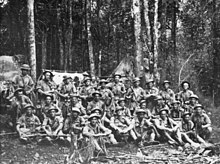
The 7th Division was an infantry division of the Australian Army. It was formed in February 1940 to serve in World War II, as part of the Second Australian Imperial Force. The division was raised on the British establishment of nine infantry battalions per division and consisted of two new brigades and three of the original 12 battalions of the 6th Division forming the third brigade. The division is sometimes known by the nickname "The Silent Seventh", due to a perception that its achievements were unrecognised, in comparison to the other Australian divisions. The origin of this belief appears to be censorship of the part played by the 7th Division in the fierce fighting in the 1941 Syria-Lebanon campaign. The 7th Division along with the 6th and 9th Australian Divisions were the only divisions to serve in both the Middle East and the South West Pacific Area. It was disbanded in 1946, following the end of the war.

Brigadier Arnold William Potts, was an Australian grazier and army officer who served in the First World War and led the 21st Brigade of the Second Australian Imperial Force during its defence of the Kokoda Track during the Second World War. He had a distinguished career, however, his place in history has largely been unacknowledged due to his dismissal by General Sir Thomas Blamey, at the very point when Potts had fought the Japanese to exhaustion. His fighting withdrawal over the Kokoda Trail has been called "one of the most critical triumphs in Australian military history and one that an apathetic nation has still to honour". Many contemporaries as well as Potts' official biographer regard this sacking as one of the most disgraceful actions of Blamey's military career. Following his dismissal, Potts went on to command the 23rd Brigade during the Bougainville campaign where he earned a reputation for setting high standards. He retired from the military following the end of the war and unsuccessfully pursued a career in politics. He died in 1968, aged 71.
Maroubra Force was the name given to the ad hoc Australian infantry force that defended Port Moresby, Papua New Guinea from the Japanese, and was involved in the Kokoda Track Campaign of the Pacific War, World War II. The force was established by the Allies under the codename "Maroubra", referring to the troops in the forward area, it was one of many units forming the body of the New Guinea Force, the main Allied army formation in the South West Pacific Area during 1942.

John Alexander French, VC was an Australian recipient of the Victoria Cross, the highest award for gallantry in the face of the enemy that can be awarded to British and Commonwealth forces. French was one of 20 Australians to receive the award for their actions during the Second World War. He was killed in action fighting against the Japanese during the Battle of Milne Bay in September 1942 while serving with the 2/9th Battalion.
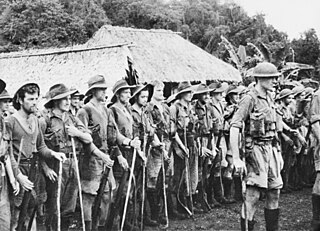
The Kokoda Track campaign or Kokoda Trail campaign was part of the Pacific War of World War II. The campaign consisted of a series of battles fought between July and November 1942 in what was then the Australian Territory of Papua. It was primarily a land battle, between the Japanese South Seas Detachment under Major General Tomitarō Horii and Australian and Papuan land forces under command of New Guinea Force. The Japanese objective was to seize Port Moresby by an overland advance from the north coast, following the Kokoda Track over the mountains of the Owen Stanley Range, as part of a strategy to isolate Australia from the United States.
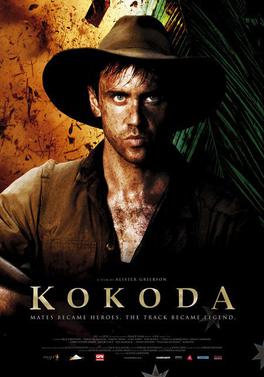
Kokoda is a 2006 Australian war film directed by Alister Grierson and is based on the experiences of Australian troops fighting Japanese forces during the 1942 Kokoda Track campaign.
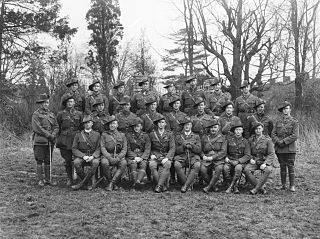
The 39th Battalion was an infantry unit of the Australian Army. It was originally raised in February 1916 for service during World War I as part of First Australian Imperial Force, with personnel being drawn mainly from the state of Victoria. Making up part of the 10th Brigade, it was attached to the 3rd Division and served on the Western Front in France and Belgium before being disbanded in March 1919. Following the re-organisation of the Australian Army in 1921, the battalion was raised again in Victoria as a unit of the Citizens Force, becoming known as the "Hawthorn–Kew Regiment". In 1937, it was amalgamated with the 37th Battalion to become the 37th/39th Battalion. Later, in August 1939 it was delinked with the 37th and amalgamated with the 24th Battalion to form the 24th/39th Battalion, before being raised again as a single unit in October 1941.
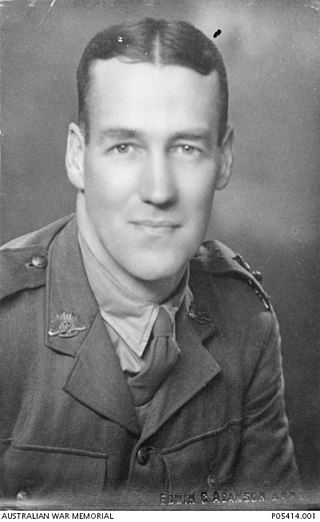
Lieutenant Colonel William Taylor Owen was an Australian Army officer who served during the Second World War. A survivor of the Battle of Rabaul, he was killed in action leading the 39th Battalion during the Kokoda Track campaign.

The 2/16th Battalion was an infantry battalion of the Australian Army, serving during World War II. Attached to the 21st Brigade that was assigned to the 7th Division, the 2/16th was raised in 1940 as part of the Second Australian Imperial Force from volunteers drawn mainly from the state of Western Australia. After training in Australia, the battalion was deployed to the Middle East where it undertook defensive duties along the Egyptian–Libyan border in early 1941 before taking part in the Syria–Lebanon campaign, fighting against Vichy French forces in June and July. At the conclusion of the campaign, the 2/16th remained in Lebanon, contributing to the Allied occupation force there, before returning to Australia in early 1942 following Japan's entry into the war. In August 1942, they were committed to the fighting along the Kokoda Track and then later fought around Buna and Gona. After a period of rest and reorganisation in Australia, the battalion fought around Lae and then took part in the Finisterre Range campaign in 1943–44. Its final campaign of the war came in Borneo in July 1945. At the end of the war, the 2/16th were disbanded in January 1946.
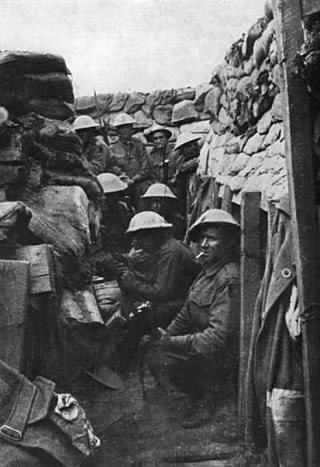
The 53rd Battalion was an infantry battalion of the Australian Army. Raised in 1916 for service during World War I the battalion served on the Western Front until the end of the war, before being briefly amalgamated with the 55th Battalion and then eventually disbanded in 1919. In 1921, the 53rd Battalion was re-raised and in 1927 adopted the title of the "West Sydney Regiment". In 1937 they were once again amalgamated with the 55th, forming the 55th/53rd Battalion.

The 30th Brigade was a brigade-sized infantry unit of the Australian Army. Formed in December 1941, as part of the Militia, the unit was raised for service during the Second World War. Established in response to Japan's entry into the war, the brigade's subordinate units were established in several Australian states. Some of these had already been dispatched to New Guinea before the brigade's headquarters was established, although the majority arrived there in early 1942. Following their arrival, the brigade initially provided garrison troops to Port Moresby before later taking part in the fighting along the Kokoda Track during which elements took part in delaying actions around Kokoda and Isurava, before being relieved by units of the Second Australian Imperial Force. After the campaign began to turn in favour of the Australians, the Japanese withdrew north towards their beachheads around Buna and Gona, and elements of the brigade were recommitted to the fighting. In early 1943, the 30th Brigade was withdrawn back to Australia and was disbanded in July 1943, with its personnel being redistributed to other formations.

The invasion of Buna–Gona, called Operation RI by the Japanese, was a military operation by Imperial Japanese forces to occupy the Buna–Gona area in the Territory of Papua during the Pacific campaign of the Second World War. The initial landings and advance on Kokoda occurred between 21 and 27 July 1942. The Japanese invaded and occupied the location in preparation for an overland attack on Port Moresby along the Kokoda Track. The landing marked the start of the Kokoda Track campaign. The landings were not directly opposed by land forces but were engaged by elements of Maroubra Force as they advanced on Kokoda. This initially included B Company of the 39th Battalion, patrols of the Papuan Infantry Battalion (PIB) operating in the area and a small number of the Australian New Guinea Administrative Unit (ANGAU) that became attached to the force. The Australians were initially repulsed near Oivi but subsequently regrouped to defend Kokoda in an initial battle there from 28–29 July.
Stan Bisset MC OAM was an Australian national representative rugby union player and military officer who saw active service in the Second World War.

The 2/14th Battalion was an infantry battalion of the Australian Army that served during World War II. Part of the 21st Brigade, 7th Division, the battalion was raised from Second Australian Imperial Force volunteers drawn mainly from the state of Victoria. After completing training in Australia in 1940, the battalion deployed to the Middle East where it was stationed in Egypt and Palestine before it saw action against the Vichy French in Syria in June and July 1941, in a short lived campaign. Garrison duties in Lebanon followed before the battalion was withdrawn to Australia in early 1942 as Australian forces were concentrated in the Pacific to respond to the threat posed by Japan's entry into the war.

The 2/27th Battalion was an infantry battalion of the Australian Army during World War II. Raised in May 1940 as part of the 7th Division from volunteers from the state of South Australia, the battalion was assigned to the 21st Brigade. After completing training in Australia, the 2/27th deployed to the Middle East in November 1940, and in early 1941 undertook defensive duties in the Western Desert. The battalion's first combat experience came against the Vichy French during the short Syria–Lebanon campaign during which it fought major engagements around Sidon and Damour. At the conclusion of the fighting in Syria, the battalion remained in the area as part of the Allied occupation force until early 1942 when it was returned to Australia to fight against the Japanese.

The Battle of Isurava, also sometimes referred to as the Battle of Isurava – Abuari or the Battle of Isuraba, took place between 26 and 31 August 1942. Forming part of the Kokoda Track campaign of the Second World War, the battle involved military forces from Australia, supported by the United States, fighting against Japanese troops from Major General Tomitaro Horii's South Seas Detachment, who had landed around Buna and Gona in Papua mid-July 1942, with the intent of capturing Port Moresby to the south, via the overland route.

The Battle of Mission Ridge–Brigade Hill took place between 6 and 9 September 1942, during the Kokoda Track campaign of the Second World War. Involving forces from Australia, the United States, and Japan, the fighting centred on a high feature south of the village of Efogi on the Kokoda Track.

The Battle of Ioribaiwa took place between 14 and 16 September 1942, during the Kokoda Track campaign in Papua during the Second World War. Involving forces from Australia, the United States, and Japan, the fighting centred on a high feature known as Ioribaiwa Ridge, south of Ofi Creek on the Kokoda Track, in the Territory of Papua. It was the last of three defensive battles fought by the Australians along the Kokoda Track to halt the Japanese advance from the north coast of Papua towards Port Moresby.

The Battle of Kokoda consisted of two engagements fought in late July – early August 1942. Forming part of the Kokoda Track campaign of the Second World War, the battle involved military forces from Australia, supported by the United States, fighting against Japanese troops from Major General Tomitaro Horii's South Seas Detachment who had landed around Buna and Gona in Papua mid-July 1942, with the intent of capturing Port Moresby to the south via the overland route.

The First Battle of Eora Creek–Templeton's Crossing was fought from 31 August 1942 to 5 September 1942. Forming part of the Kokoda Track campaign of the Second World War, the battle involved military forces from Australia, supported by the United States, fighting against Japanese troops from Major General Tomitaro Horii's South Seas Detachment who had landed in Papua in mid-1942, with the intent of capturing Port Moresby. The battle was one of three defensive actions fought by the Australians along the Kokoda Track. The fighting resulted in the delay of the Japanese advance south, which allowed the Australians to withdraw to Efogi. Eora Creek village and Templeton's Crossing was subsequently the site of a battle in late October 1942 as the Australian forces pursued the Japanese forces retiring back toward the north coast of Papua.

